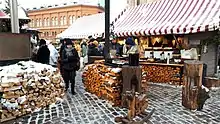Christmas market
A Christmas market, also known as Christkindlmarkt (literally: Christ Child Market, but the term "Christkind" usually refers to an angel-like "spirit of Christmas" rather than literally the Christ Child), Christkindlesmarkt, Christkindlimarkt, and Weihnachtsmarkt, is a street market associated with the celebration of Christmas during the four weeks of Advent.[1] These markets originated in Germany, but are now held in many countries.[2] Some in the U.S. have adapted the name to the quasi-German Christkindlmarket, substituting market for German Markt.[3][4]


Christmas markets date to the Late Middle Ages in the German-speaking part of Europe and in many parts of the former Holy Roman Empire that included many eastern regions of France.[2] They became a popular Advent custom during the Reformation era.[1] Dresden's Striezelmarkt was first held in 1434 and one of the first true Christmas markets;[5] earlier markets of the season were "December markets".[5][6] Early mentions of these "December markets" can be found in Vienna (1298),[7] Munich (1310),[5] Bautzen (1384),[8] and Frankfurt (1393).[9]
In many towns in Germany, Switzerland, and Austria, Advent is usually ushered in with the opening of the Christmas market or "Weihnachtsmarkt". In southern Germany, Switzerland and Austria, it is called a "Christkind(e)l(s)(i)markt" (German language, literally meaning "Christ child market"). Traditionally held in the town square, the market offers food, drinks and seasonal items for sale from open-air stalls, accompanied by traditional singing and dancing. On opening night at the Christkindlesmarkt in Nuremberg, and in some other towns, onlookers welcome the "Christkind" (originally boy Jesus, but often depicted as an angel-like girl), acted by a local child.
Attractions and stalls
Popular attractions at the markets include the Nativity Scene (a crèche or crib), Zwetschgenmännle (figures made of decorated dried plums), Nussknacker (carved Nutcrackers), Gebrannte Mandeln (candied, toasted almonds), traditional Christmas cookies such as Lebkuchen and Magenbrot (both forms of soft gingerbread), Bratwurst, and Glühwein, hot mulled wine (with or without a shot of brandy), or Eierpunsch (an egg-based warm alcoholic drink) - both a highlight of the market for many visitors. Both help stave off the cold winter air which sometimes dips below freezing. More regional food specialties include Christstollen (Stollen), a sort of bread with candied fruit in Saxony, and hot Apfelwein and Frankfurter Bethmännchen in Hesse.
Major Christmas markets
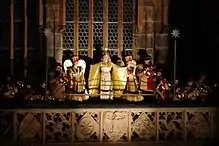
Famous Christmas markets are held in the cities of Augsburg, Dresden, Erfurt, Frankfurt, Nuremberg, and Stuttgart, making them popular tourist attractions during the Christmas holiday season.[10][11] The Nuremberg and Dresden markets draw about two million people each year; the Stuttgart and Frankfurt markets attract more than three million visitors.
The two most visited Christmas markets in Germany are found in Dortmund, with more than three and a half million visitors of 300 stalls around a gigantic Christmas tree that stands 45 metres (148 ft) tall, and in Cologne with 4 million people.[12] Additionally, the city of Berlin claims more than 70 markets, which open in late November and close just after Christmas.[13]
Christmas markets are also popular traditions in Austria, and are held in Vienna, Salzburg, Innsbruck, Linz, and Graz. The first "December Market" was held in Vienna in 1298.[14] Vienna holds 20 different Christmas markets around the city.[14] Most Christmas markets open in late November and last through December, closing right after 25 December, with a few staying open for New Year's.[15] The largest Christmas market and one of the most well known is the Vienna Christmas World on Rathausplatz, near the Rathaus, Vienna's historic city hall. The market draws 3 million people each year and includes 150 unique stalls that offer traditional Austrian foods, Christmas decorations and ornaments, handicrafts, and drinks.[16][17] The Vienna Christmas World on Rathausplatz also features an advent theme park called the Adventzauber with workshops and cultural performances that cater to families and young children. Visitors to the Vienna Christmas World can also ice skate on a 3,000-square-metre (32,000 sq ft) ice rink and on frozen paths that run through the Rathausplatz Park.[16] Other famous Christmas markets include the Christmas Market at Schönbrunn Palace, the Art Advent on Karlsplatz, the Christmas Village at Belvedere Palace, and the Christmas Village on Maria-Theresien-Platz.[17] The Christmas Market at Schönbrunn Palace, “Kultur-und-Weihnachtsmarkt,” takes place in front of the imperial palace. It features Austrian handicrafts and goods as well as a cultural program with activities and workshops. The Art Advent on Karlsplatz offers artisan goods, a children's program, and a petting zoo.[18] Popular food specialities include Kinderpunsch (a non-alcoholic punch), Glühwein, Baumstriezel (a Hungarian pastry coated in cinnamon and sugar), Kartoffelpuffer (potato pancakes), Lángos (savory deep fried dough), Schaumkuss (chocolate covered marshmallows), Stollen (bread with candied fruit), Maroni (roasted chestnuts), Bratkartoffel (roasted potato wedges), Lebkuchen (Austrian gingerbread), and baked potatoes.
Christmas markets are traditional in Alsace, and most of the towns have their local Christmas market.[19] Strasbourg, in Alsace, France, has been holding a Christmas market, "Christkindelsmärik," around its cathedral since 1570, when the city was part of the Holy Roman Empire of the German Nation.[20]
As noted, other countries have also established such markets. The Christmas market of Barcelona starts on 13 December, Saint Lucy's Day, and is called Fira de Santa Llúcia. It has been held in the square of Barcelona Cathedral since 1786.[21][22]
In 1982, Lincoln, England, established an annual Christmas market in early December. This remains one of the most extensive such market by area in the United Kingdom, with a claimed total of over 300 stalls attracting more than 100,000 visitors over its four days. Starting in 1997, Frankfurt Christmas Markets were established with support from Frankfurt in Birmingham, Edinburgh, Leeds, and Manchester.[23] Other large Christmas markets have been held in England in Bath (since 2000) and Liverpool (since 2006). The Christmas markets are such a success that they are becoming a major pull factor to increase trade and visitor numbers to towns and cities.
Birmingham's Christmas Market, primarily located on New Street between the Bullring shopping centre and the Council House, is the "largest outdoor Christmas market in the UK"[24] as well as the "largest authentic German Christmas market outside of Germany or Austria".[25] The market also offers live entertainment on the main stage. The market is held for approximately six weeks every year and usually closes around 23 December. Manchester's Christmas Markets have also been successful, with 300 stalls over eight city locations, with each location being themed to create a different atmosphere such as French, World, and German, with European-themed stalls on the Albert Square, Manchester proving to be the most popular.[26][27]
German immigrants carried Christmas market celebrations to the United States. It is celebrated in such cities as Chicago, Denver, and Tulsa.[28][29][30][31][32]
A traditional Christmas market was held for the first time in Sibiu, Romania, in 2007.[33]
Gallery
.jpg.webp) Tallinna Jõuluturg in Tallinn, Estonia
Tallinna Jõuluturg in Tallinn, Estonia Christmas market in Jena, Germany
Christmas market in Jena, Germany Malmö Christmas market 2016 Dews events Malmö, Sweden
Malmö Christmas market 2016 Dews events Malmö, Sweden In Colmar, Germany
In Colmar, Germany.jpg.webp) Christkindelsmärik, Strasbourg, France
Christkindelsmärik, Strasbourg, France Traditional gingerbread hearts at a Berlin Christmas market
Traditional gingerbread hearts at a Berlin Christmas market Christmas market in Erfurt, Germany
Christmas market in Erfurt, Germany Christmas market at the Senate Square in Helsinki, Finland
Christmas market at the Senate Square in Helsinki, Finland.jpg.webp) Christmas market at the Red Square, Moscow, Russia
Christmas market at the Red Square, Moscow, Russia 2009 Julmarknad ("Christmas market") in Gamla stan, Stockholm, Sweden
2009 Julmarknad ("Christmas market") in Gamla stan, Stockholm, Sweden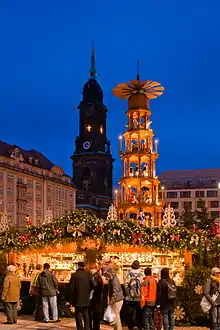 The Striezelmarkt in Dresden, Germany
The Striezelmarkt in Dresden, Germany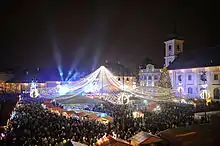 The Sibiu Christmas Market in Sibiu, Romania
The Sibiu Christmas Market in Sibiu, Romania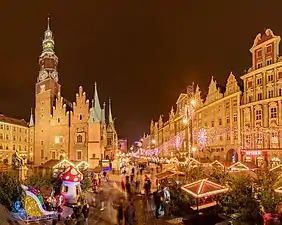 The Christmas Market in Wrocław, Poland
The Christmas Market in Wrocław, Poland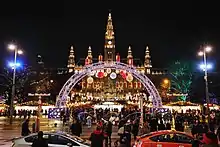 Christmas market in Vienna, Austria
Christmas market in Vienna, Austria Annual Christmas Market at Waddesdon Manor, UK
Annual Christmas Market at Waddesdon Manor, UK
References
- Larsen, Timothy (2020). The Oxford Handbook of Christmas. Oxford University Press. p. 151. ISBN 978-0-19-883146-4.
Similarly, Christmas markets (aka Christkindlsmarkt) are common during Advent, a Reformation era tradition that has spread from Germany to other countries.
- "German Christmas markets: Seasonal shopping at its finest". The Independent. 11 November 2012. Retrieved 8 December 2016.
- "The Christkindlmarket 2022". Retrieved 31 December 2022.
- "Christkindlmarket". Retrieved 31 December 2022.
- "Christmas Markets in Germany and Europe". The German Way & More. Retrieved 30 October 2019.
- "Geschichte des Wiener Christkindlmarkts - Weihnachts- und Adventmarkt". www.wien.gv.at (in German). Archived from the original on 16 February 2020. Retrieved 30 October 2019.
- "Christmas markets in Vienna". Austrian National Tourist Office. Retrieved 2 April 2017.
- Darmstadt, IDL Software GmbH. "Weihnachtsmarkt in Bautzen - Weihnachten 2016". Retrieved 25 December 2016.
- "Frankfurt Christmas Markets in Great Britain | Frankfurt Tourism". Frankfurt Tourismus. 27 December 2014. Archived from the original on 27 December 2014. Retrieved 30 October 2019.
- Christmas City Nuremberg Stadt Nürnberg. Retrieved 8 July 2007
- Stuttgart Christmas Market Archived 22 April 2008 at the Wayback Machine Stuttgart Marketing. Retrieved 8 July 2007
- "Weihnachtsmärkte: Köln ist Publikumsmagnet : Topnews". Topnews.de. Archived from the original on 12 June 2017. Retrieved 6 May 2013.
- Innes said... (26 December 2011). "Top Berlin Christmas Markets". On London Time. Archived from the original on 11 March 2012. Retrieved 6 May 2013.
- "Christmas Markets in Vienna". Austria. Retrieved 31 August 2018.
- "Christmas Market on the Main Square in Krakow". Retrieved 4 June 2020.
- "Visit Top Christmas Markets (Weihnachtsmarkt) in Vienna". European Traveler. 12 August 2017. Retrieved 31 August 2018.
- "Christmas markets". VIENNA – Now. Forever. Retrieved 31 August 2018.
- "Vienna Christmas Market Guide and Map 2018". Vienna Unwrapped. Retrieved 31 August 2018.
- Christmas markets
- Noël à Strasbourg Archived 17 August 2007 at the Wayback Machine Retrieved 8 July 2007
- Christmas Market
- History
- "Frankfurt Christmas Markets Great Britain Scotland England". Frankfurt-tourismus.de. Archived from the original on 10 May 2013. Retrieved 6 May 2013.
- Bentley, David (20 September 2018). "These are the dates for Birmingham German Christmas Market 2018". birminghammail. Retrieved 5 November 2018.
- "Frankfurt Christmas Market Birmingham | 15 November 2018 to 23 December 2018". www.thebfcm.co.uk. Retrieved 5 November 2018.
- Denise Evans (18 November 2012). "Manchester Christmas Markets 2012: A guide to the city's festive stalls - Manchester Evening News". Menmedia.co.uk. Archived from the original on 22 October 2012. Retrieved 6 May 2013.
- "Mapped: Manchester set for 'biggest and best ever' Christmas markets - Manchester Evening News". Menmedia.co.uk. 2 November 2012. Archived from the original on 5 November 2012. Retrieved 6 May 2013.
- CHRISTKINDLMARKT BETHLEHEM ArtsQuest (2006). Retrieved 8 July 2007
- Christkindlmarket Chicago Archived 3 March 2007 at the Wayback Machine German American Chamber of Commerce of the Midwest, 17 November 2006. Retrieved 8 July 2007
- Denver Christkindl Market German American Chamber of Commerce Colorado Chapter. (2006). Retrieved 8 July 2007
- Donner. "Mifflinburg Christkindl Market". Retrieved 25 December 2016.
- Christkindlmarkt 2007 Archived 17 December 2007 at the Wayback Machine German-American Society of Tulsa, 1 May 2007. Retrieved 8 July 2007
- (http://www.graffino.com), Graffino. "Târgul de Crăciun din Sibiu". Retrieved 25 December 2016.
Further reading
- Bakst, Alex: "A Visit to Germany's Christmas Markets", Spiegel Online 7 December 2006
- Zug, J.D. (1991): German-American Life: Recipes and Traditions, Iowa City: Penfield Press
External links
 Media related to Christmas markets at Wikimedia Commons
Media related to Christmas markets at Wikimedia Commons Christmas markets travel guide from Wikivoyage
Christmas markets travel guide from Wikivoyage
